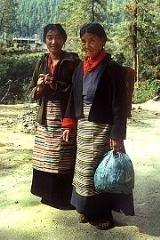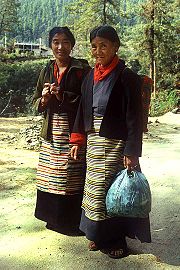
Women in Bhutan
Encyclopedia

Bhutan
Bhutan , officially the Kingdom of Bhutan, is a landlocked state in South Asia, located at the eastern end of the Himalayas and bordered to the south, east and west by the Republic of India and to the north by the People's Republic of China...
has encouraged greater participation by the women in Bhutan in political and administrative life, male members of the traditional aristocracy dominate the social system. Economic development
Economic development
Economic development generally refers to the sustained, concerted actions of policymakers and communities that promote the standard of living and economic health of a specific area...
has increased opportunities for women to participate in fields such as medicine, both as physicians and nurses; teaching; and administration. By 1989 nearly 10 percent of government employees were women, and the top civil service examination graduate in 1989 was a woman. During their government careers, women civil servants were allowed three months maternity leave with full pay for three deliveries and leave without pay for any additional deliveries. Reflecting the dominance of males in society, girls were outnumbered three to two in primary and secondary-level schools.
Political participation
Between 2008 and 2011, recruitment and retention of Tshogpas, or local government council members, remained a serious issue. Obstacles range from lack of interest and lack of economic incentives to difficulty in compliance and obtaining accreditation under existing election laws. The functional literacy and skills test alone left many constituencies without the minimum of two candidates, leading to lengthy delay of the local government elections of 2011Bhutanese local government elections, 2011
The Bhutanese local government elections of 2011 were originally slated for 2008, but were delayed until 2011. Elections began on January 20, 2011, however polls opened in only 3 of 20 districts – Thimphu, Chukha District , and Samdrup Jongkhar – as part of a staggered election schedule. Polls...
, originally slated for 2008. The first round of the functional literacy and skills test left many Gewog
Gewog
A gewog, or geog refers to a group of villages in Bhutan. Gewogs form a geographic administrative unit below dzongkhag districts , and above thromde municipalities. Bhutan comprises 205 gewogs, which average 230 km² in area...
s with no representatives, though second round results showed a pass rate over 90%. Although women elected to office remained relatively few (14% before local elections according to the UNHCR), more than half of voters in initial local government elections were women. In initial local-level voting in 2011, voter turnout was about 50%. This has raised the question of whether women would benefit from quotas in public service, highlighting the need to encourage further female electoral and political participation.
History
Women in the 1980s played a significant role in the agriculturalAgriculture
Agriculture is the cultivation of animals, plants, fungi and other life forms for food, fiber, and other products used to sustain life. Agriculture was the key implement in the rise of sedentary human civilization, whereby farming of domesticated species created food surpluses that nurtured the...
work force, where they outnumbered men, who were leaving for the service sector and other urban industrial and commercial activities. In the mid-1980s, 95 percent of all Bhutanese women from the ages of fifteen to sixty-four years were involved in agricultural work, compared with only 78 percent of men in the same age range. Foreign observers have noted that women shared equally with men in farm labor. Overall, women were providing more labor than men in all sectors of the economy. Less than 4 percent of the total female work force was unemployed, compared with nearly 10 percent of men who had no occupation.
The government founded the National Women's Association of Bhutan in 1981 primarily to improve the socioeconomic status of women, particularly those in rural areas. The association, at its inaugural session, declared that it would not push for equal rights for women because the women of Bhutan had already come to "enjoy equal status with men politically, economically, and socially." To give prominence to the association, the Druk Gyalpo's sister, Ashi Sonam Chhoden Wangchuck, was appointed its president. Starting in 1985, the association became a line item in the government budget and was funded at Nu2.4 million in fiscal year 1992. The association has organized annual beauty contest
Beauty contest
A beauty pageant or beauty contest, is a competition that mainly focuses on the physical beauty of its contestants, although such contests often incorporate personality, talent, and answers to judges' questions as judged criteria...
s featuring traditional arts and culture, fostered training in health and hygiene, distributed yarn and vegetable seeds, and introduced smokeless stoves in villages.
Traditional marriage and family life
The traditional practice, arranged marriages based on family and ethnic ties, had been replaced in the late twentieth century with marriages based on mutual affection. Marriages were usually arranged by the partners in contemporary Bhutan, and the minimum age was sixteen for women and twenty-one for men. The institution of child marriageChild marriage
Child marriage and child betrothal customs occur in various times and places, whereby children are given in matrimony - before marriageable age as defined by the commentator and often before puberty. Today such customs are fairly widespread in parts of Africa, Asia, Oceania and South America: in...
, once relatively widespread, largely declined as Bhutan modernized, and there were only remnants of the practice in the late twentieth century. Interethnic marriages, once forbidden, were encouraged in the late 1980s by an incentive of a Nu10,000 government stipend to willing couples. The stipend was discontinued in 1991, however. Marriages of Bhutanese citizens to foreigners, however, have been discouraged. Bhutanese with foreign spouses were not allowed to obtain civil service positions and could have their government scholarships cancelled and be required to repay portions already received. Foreign spouses were not entitled to citizenship by right but had to apply for naturalization.
Polyandry
Polyandry
Polyandry refers to a form of marriage in which a woman has two or more husbands at the same time. The form of polyandry in which a woman is married to two or more brothers is known as "fraternal polyandry", and it is believed by many anthropologists to be the most frequently encountered...
was abolished and polygamy
Polygamy
Polygamy is a marriage which includes more than two partners...
was restricted in the mid-twentieth century. Through the 1990s, however, the law still allowed a man as many as three wives, providing he had the first wife's permission. The first wife also had the power to sue for divorce and alimony if she did not agree. In the 1980s, divorce was common, and newer laws provided better benefits to women seeking alimony.
Family life, both traditionally and through the end of the 20th century, was likely to provide for a fair amount of self-sufficiency. Families, for example, often made their own clothing, bedding, floor and seat covers, tablecloths, and decorative items for daily and religious use. Wool was the primary material, but domestic silk and imported cotton were also used in weaving colorful cloth, often featuring elaborate geometric, floral, and animal designs. Although weaving was normally done by women of all ages using family-owned looms, monks sometimes did embroidery and appliqué
Applique
In its broadest sense, an appliqué is a smaller ornament or device applied to another surface. In the context of ceramics, for example, an appliqué is a separate piece of clay added to the primary work, generally for the purpose of decoration...
work. In the twentieth century, weaving was possibly as predominant a feature of daily life as it was at the time of Bhutan's unification in the seventeenth century.
Landholdings varied depending on the wealth and size of individual families, but most families had as much land as they could farm using traditional techniques. A key element of family life was the availability of labor. Thus, the choice of the home of newlyweds was determined by which parental unit had the greatest need of supplemental labor. If both families had a sufficient supply of labor, then a bride and groom might elect to set up their own home.<

